PONTIAC BONNEVILLE 1998 Workshop Manual
Manufacturer: PONTIAC, Model Year: 1998, Model line: BONNEVILLE, Model: PONTIAC BONNEVILLE 1998Pages: 395, PDF Size: 17.6 MB
Page 51 of 395
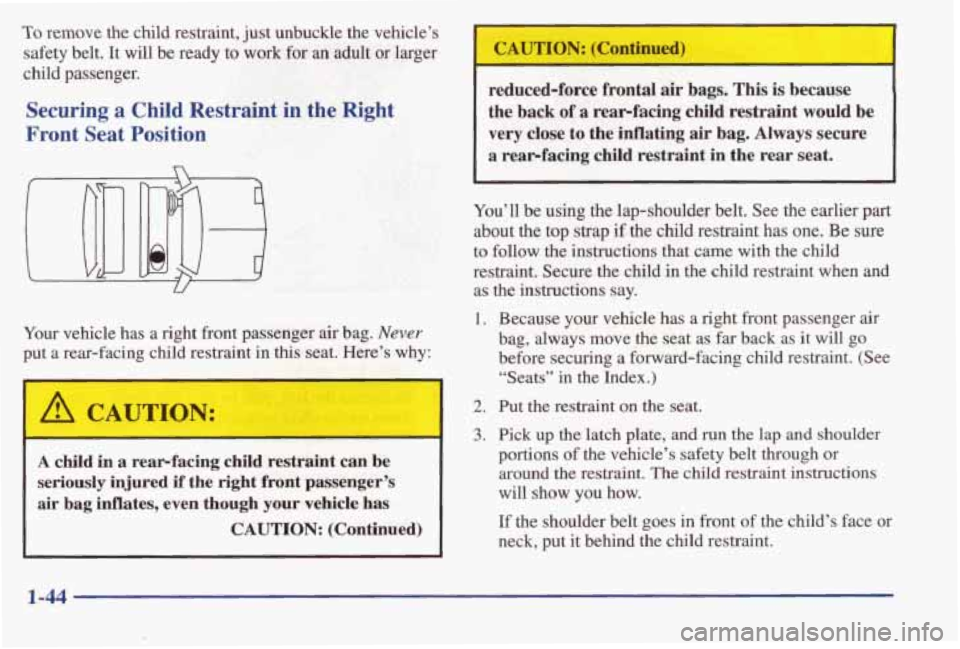
To remove the child restraint, just unbuckle the vehicle’s
safety belt. It will be ready to work
for an adult or larger
child passenger.
Securing a Child Restraint in the Right
Front
Seat Position
Your vehicle has a right front passenger air bag. Never
put a rear-facing child restraint in this seat. Here’s why:
I A CAUTION:
reduced-force frontal air bags. This is because
the back of a rearfacing child restraint
would be
very close
to the inflating air bag. Always secure
a rearfacing child restraint in the rear seat.
A child in a rearfacing child restraint can be
seriously injured if the right front passenger’s
air bag inflates, even though
your vehicle has
CAUTION: (Continued)
You’ll be using the lap-shoulder belt. See the earlier part
about the top strap if. the child restraint has one. Be sure
to follow the instructions that came with the child
restraint. Secure the child
in the child restraint when and
as the instructions
say.
1. Because your vehicle has a right front passenger air
bag, always move the seat as
far back as it will go
before securing a forward-facing child restraint. (See
“Seats” in the Index.)
’ 2. Put the restraint on the seat.
3. Pick up the latch plate, and run the lap and shoulder
portions
of the vehicle’s safety belt through or
around the restraint. The child restraint instructions
will show you
how.
If the shoulder belt goes in front of the child’s face or
neck, put it behind the child restraint.
1-44
Page 52 of 395
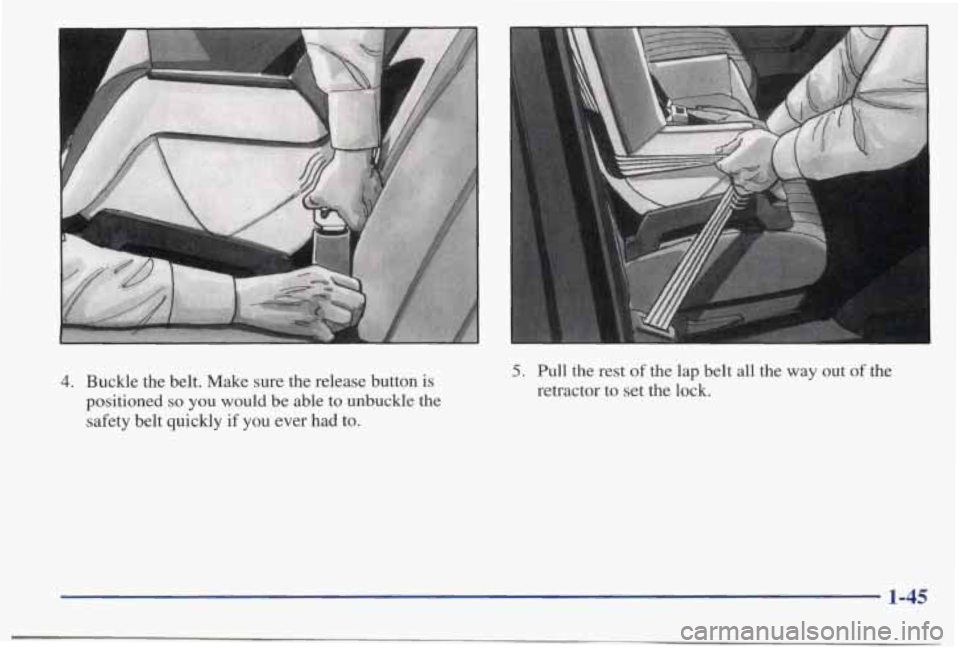
A
A
4. Buckle the belt. Make sure the release button is
positioned so you would be able to unbuckle the
safety belt quickly if you ever had to.
5. Pull the rest of the lap belt all the way out of the
retractor to set the lock.
1-45
Page 53 of 395
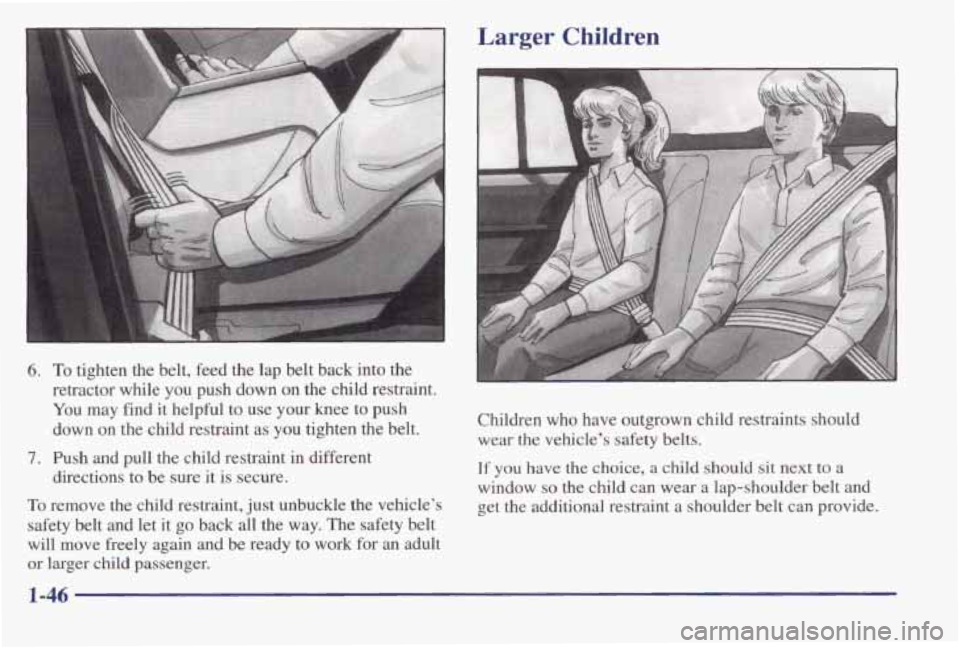
6. To tighten the belt, feed the lap belt back into the
retractor while you push down on the child restraint.
You may find it helpful to use your knee to push
down
on the child restraint as you tighten the belt.
directions to be sure it is secure.
7. Push and pull the child restraint in different
To remove the child restraint, just unbuckle the vehicle's
safety belt and let it
go back all the way. The safety belt
will move freely again
and be ready to work for an adult
or larger child passenger.
Larger Children
t'
Children who have outgrown child restraints should
wear
the vehicle's safety belts.
If you have the choice, a child should sit next to a
window so the child can wear a lap-shoulder belt and
get the additional restraint a shoulder belt can provide.
1-46
Page 54 of 395
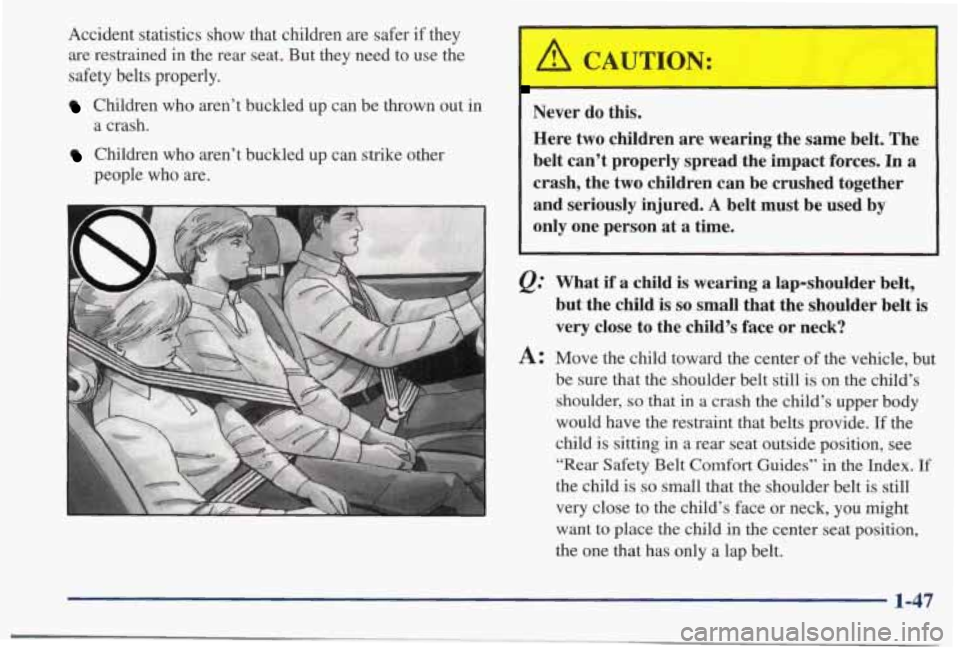
Accident statistics show that children are safer if they
are restrained in the rear seat. But they need to use the
safety belts properly.
Children who aren’t buckled up can be thrown out in
Children who aren’t buckled up can strike other
a
crash.
people who are.
Never do this.
Here two children are wearing the same belt. The
belt can’t properly spread the impact forces. In a
crash, the two children can be crushed together
and seriously injured.
A belt must be used by
only one person at a time.
&.’ What if a child is wearing a lap-shoulder belt,
but the child is
so small that the shoulder belt is
very close to the child’s face or neck?
A: Move the child toward the center of the vehicle, but
be sure that the shoulder belt still is on the child’s
shoulder,
so that in a crash the child’s upper body
would have the restraint that belts provide.
If the
child is sitting in a rear seat outside position, see
“Rear Safety Belt
Comfort Guides” in the Index. If
the child is so small that the shoulder belt is still
very close to the child’s face or neck, you might
want to place the child
in the center seat position,
the one that has only a lap belt.
1-47
Page 55 of 395
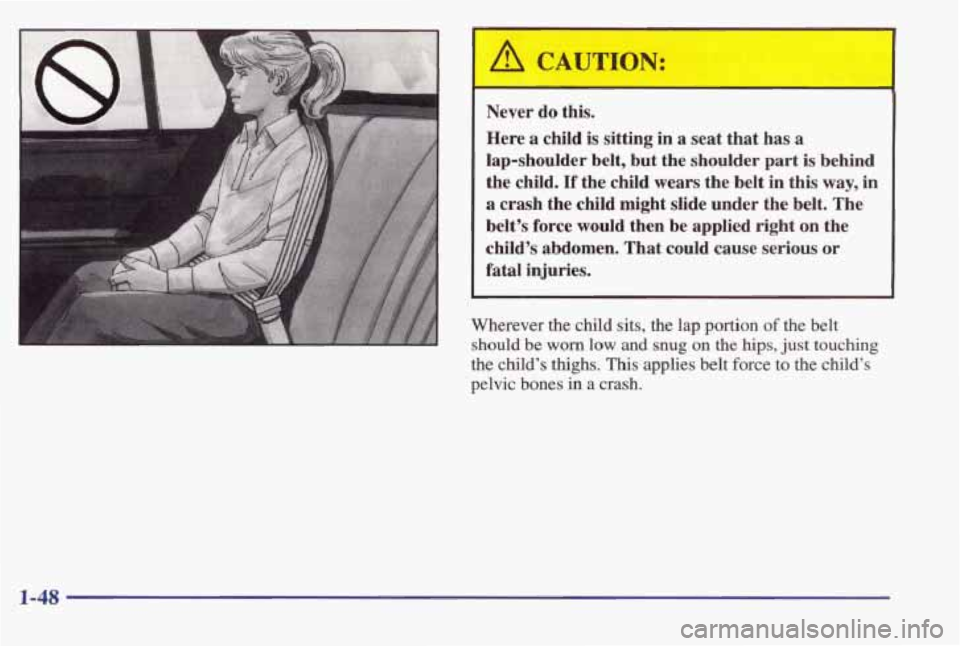
/1 CAUTION:
.
Never do this.
Here
a child is sitting in a seat that has a
lap-shoulder belt, but the shoulder part is behind
the child.
If the child wears the belt in this way, in
a crash the child might slide under the belt. The
belt’s force
would then be applied right on the
child’s abdomen. That could cause serious
or
fatal injuries.
Wherever the child sits, the lap portion of the belt
should be worn low and snug on the hips, just touching
the child’s thighs. This applies belt force to the child’s
pelvic bones
in a crash.
1-48
Page 56 of 395
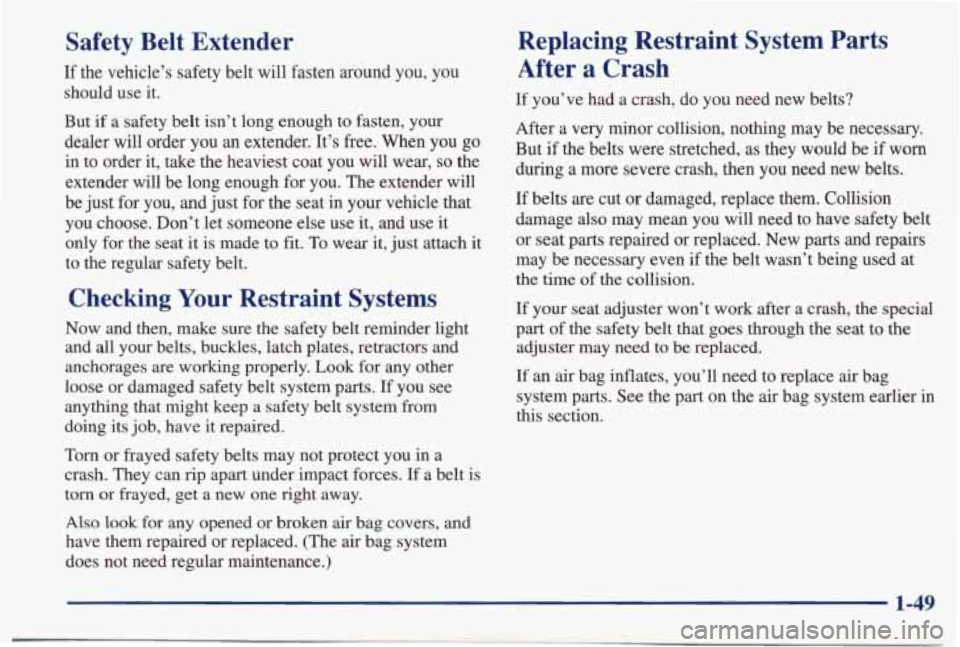
Safety Belt Extender
If the vehicle’s safety belt will fasten around you, you
should use it.
But if a safety belt isn’t long enough to fasten, your
dealer will order you
an extender. It’s free. When you go
in to order it, take the heaviest coat you will wear,
so the
extender will be long enough for you. The extender will
be just for you, and just for the seat in your vehicle that
you choose. Don’t let someone else use it, and use it
only for the seat
it is made to fit. To wear it, just attach it
to the regular safety belt.
Checking Your Restraint Systems
Now and then, make sure the safety belt reminder light
and all your belts, buckles, latch plates, retractors and
anchorages are working properly. Look for any other
loose or damaged safety belt system parts.
If you see
anything that might keep a safety belt system from
doing its job, have it repaired.
Tom or frayed safety belts may not protect you in a
crash. They can rip apart under impact forces.
If a belt is
torn or frayed, get a new one right away.
Replacing Restraint System Parts
After a Crash
If you’ve had a crash, do you need new belts?
After a very minor collision, nothing may be necessary.
But
if the belts were stretched, as they would be if worn
during a more severe crash, then you need new belts.
If belts are cut or damaged, replace them. Collision
damage also may mean you will need to have safety belt or seat parts repaired or replaced. New parts and repairs
may be necessary even if the belt wasn’t being used at
the time of the collision.
If your seat adjuster won’t work after a crash, the special
part of the safety belt that goes through the seat to the
adjuster may need to be replaced.
If
an air bag inflates, you’ll need to replace air bag
system parts. See the part on the
air bag system earlier in
this section.
Also look for any opened or broken air bag covers, and
have them repaired or replaced. (The
air bag system
does not need regular maintenance.)
Page 57 of 395
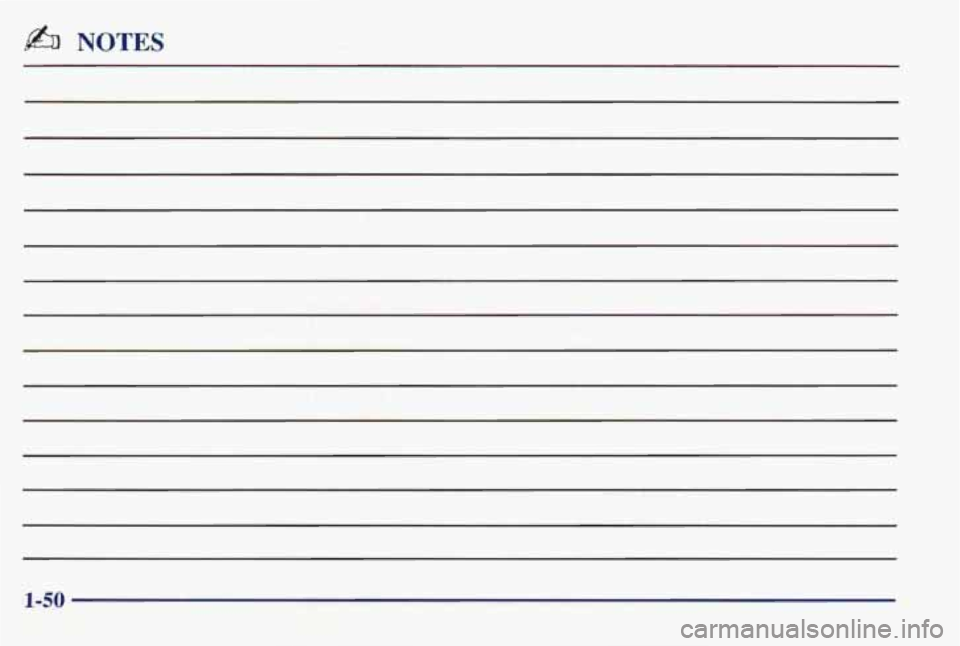
&J NOTES
1-50
Page 58 of 395
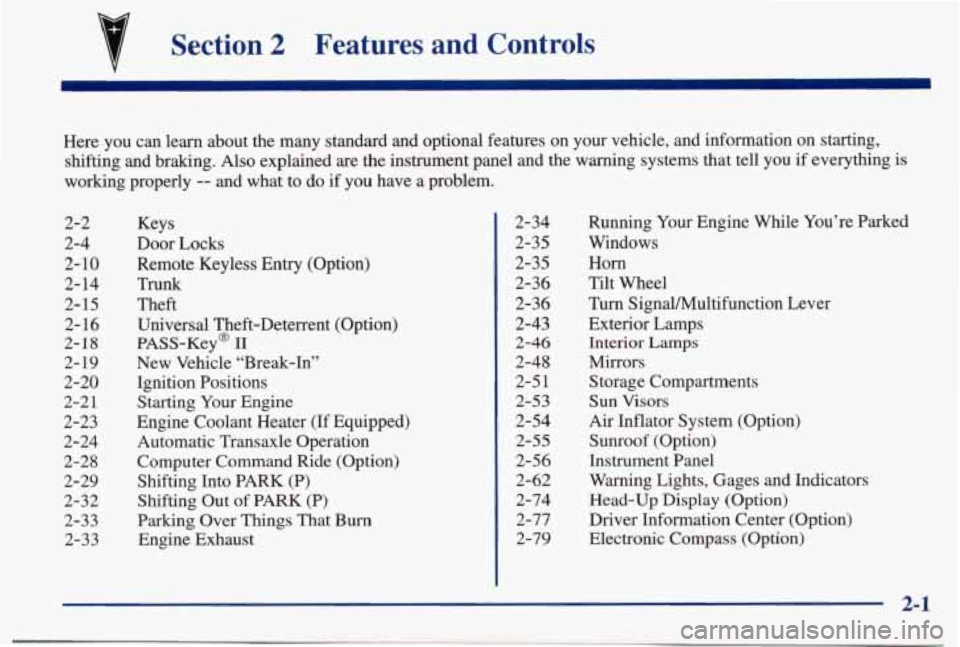
Section 2 Features and Controls
Here you can learn about the many standard and optional featur\
es on your vehicle, and information on starting,
shifting and braking.
Also explained are the instrument panel and the warning systems that tell you if everything is
working properly
-- and what to do if you have a problem.
2-2
2-4 2-
10
2- 14
2-15
2-16
2-18
2- 19
2-20
2-21
2-23
2-24
2-28
2-29 2-32
2-33 2-33 Keys
Door Locks
Remote Keyless Entry (Option)
TnXnk
Theft
Universal Theft-Deterrent (Option)
PASS-Key@
I1
New Vehicle “Break-In”
Ignition Positions
Starting
Your Engine
Engine Coolant Heater (If Equipped) Automatic Transaxle Operation
Computer Command Ride (Option)
Shifting Into PARK (P)
Shifting Out
of PARK (P)
Parking Over Things That Burn Engine Exhaust 2-34
2-35
2-35
2-36
2-36
2-43
2-46
2-48 2-5
1
2-53
2-54
2-55
2-56 2-62
2-74
2-77
2-79 Running
Your Engine While You’re Parked
Windows Horn
Tilt Wheel
Turn SignaYMultifunction Lever
Exterior Lamps
Interior Lamps
Mirrors Storage Compartments
Sun Visors
Air Inflator System (Option)
Sunroof (Option)
Instrument Panel
Warning Lights, Gages and Indicators Head-Up Display (Option)
Driver Information Center (Option)
Electronic Compass (Option)
2-1
Page 59 of 395
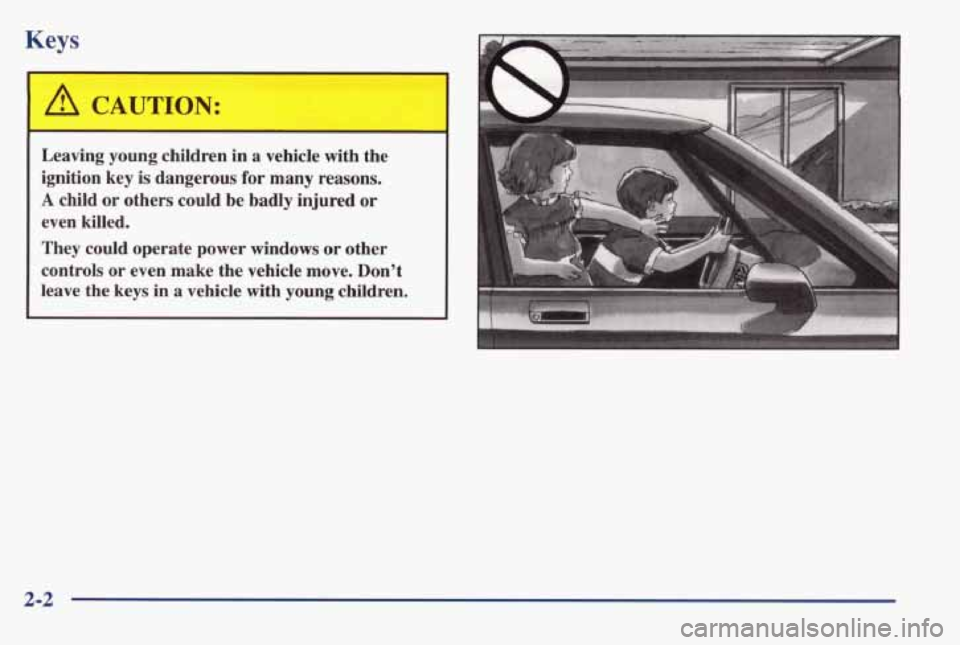
Keys
' A CAUTION:
Leaving young children in a vehicle with the
ignition key
is dangerous for many reasons.
A child or others could be badly injured or
even killed.
They could operate power windows
or other
controls
or even make the vehicle move. Don't
leave the keys in
a vehicle with young children.
2-2
Page 60 of 395
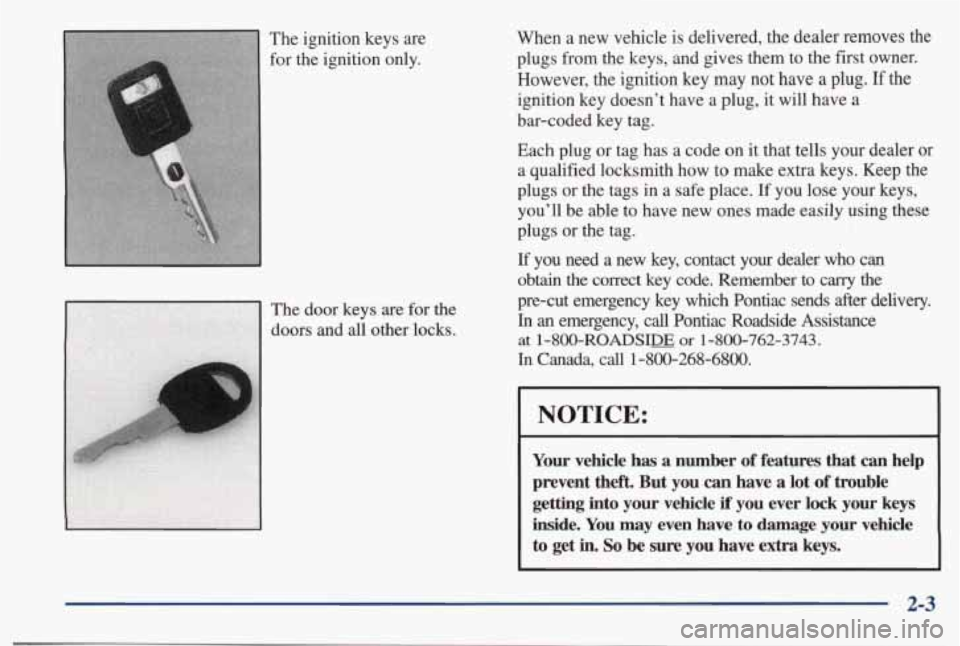
When a new vehicle is delivered, the dealer removes the
plugs from the keys, and gives them to the first owner.
However, the ignition key may not have
a plug. If the
ignition key doesn’t have a plug, it will have a
bar-coded key tag.
Each plug
or tag has a code on it that tells your dealer or
a qualified locksmith how to make extra keys. Keep the
plugs or the tags in a safe place.
If you lose your keys,
you’ll be able
to have new ones made easily using these
plugs or the tag.
If you need a new key, contact your dealer who can
obtain the correct key code. Remember to carry the
pre-cut emergency key which Pontiac sends after delivery.
In an emergency, call Pontiac Roadside Assistance
at 1 -800-ROADSIDE or 1 -8oO-762-3743.
In Canada, call 1-800-268-6800.
NOTICE:
Your vehicle has a number of features that can help
prevent the& But you
can have a lot of trouble
getting into your vehicle if you ever lock your keys
inside. You may even have to damage your vehicle
to get in. So be sure you have extra keys.
2-3